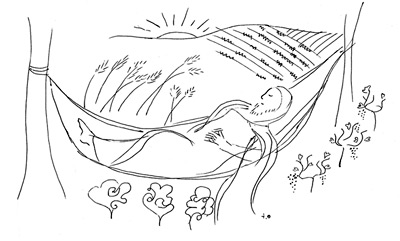 |
| Toki Oshima illustration. |
By Grace Oedel
Last month I had the privilege of attending the Hazon Food Conference in Falls Village, Connecticut, an annual gathering of people involved in the “New Jewish Food Movement” interested in growing a resilient food system rooted in religious ethics. Although many farmers might not share my voracious appetite for holy texts, I believe Biblical exploration offers us all a window into an agricultural life that sustained many generations.
This year the connection between text and resilience felt clear. Conference attendees – farmers, chefs, justice organizers, rabbis, authors and eaters – focused on a long-overlooked agricultural law in the Torah (Hebrew Bible) called “Shmita” (literally “release”). This law requires farmers to “release” their land every seven years, take an agricultural sabbatical and let their fields lie fallow. Such a law has radical implications, and we wondered if the ancient law might offer a vision of a healthier, more just, more resilient farming system today.
Understanding where the Torah introduces this law allows us to better comprehend its meaning. In Exodus the Bible lays out a litany of moral codes, including such golden rules as these: “You are not to take up an empty rumor … You are not to go after many people to do evil.” Within this same list, the text mandates, “For six years you are to sow your land and to gather in its produce, but in the seventh you are to let it go and to let it be, that the needy of your people may eat, and what remains, the wildlife of the field shall eat” (Exodus 23.1-11). Biblically, how you tend your fields comprises part of your morality.
The text goes on to explain that the “release” is not exclusively about fallowing your fields; additionally, debts are forgiven, land returns to the commons, and food staples are freely accessible to all. Shmita unites social justice, farming and sustainability. Adhering to this law would require distributing food fairly and taking care of the poor; giving fields and farmers much needed rest; allowing soil fallow time to rejuvenate; perceiving wildlife as a healthy part of a farm organism; setting aside space in society for communal rest.
How modern-day farmers can practically enact this seventh year sabbatical is not yet clear. Is it realistic to take such a large amount of time off from farming? Given most farmers’ income, how will they to sustain themselves during a rest year? Would we have enough to eat?
One important piece of this puzzle is that Biblical farming was largely a perennial agriculture system. Of the seven staple crops – olives, grapes, wheat, barley, figs, dates and pomegranates – five are perennial and two were much wilder grains that sometimes self-seeded. Unlike in modern, annual-intensive farms, a Biblical farmer might have been able to walk away from his fields for a year.
We explored other ideas to support the practicality of Shmita in addition to perennial crops. We imagined communal tending of animals, with neighbors sharing milk cows or chicken duties (animal products are allowed during the sabbatical year). We envisioned communal eating spaces, where food processing, storing and cooking could take place. We imagined strong local economies that would come with money flowing into local farms and cycling every seven years.
I left wondering how a return to a practice of sabbatical might change not only agriculture, but all of society. What would it mean to set aside time to release our fields, and ourselves?
About the author: Grace Oedel is MOFGA’s educational events coordinator. She obtained her BA at Yale University where she studied ecological theology. She has been involved in agriculture and social justice since her college years.
